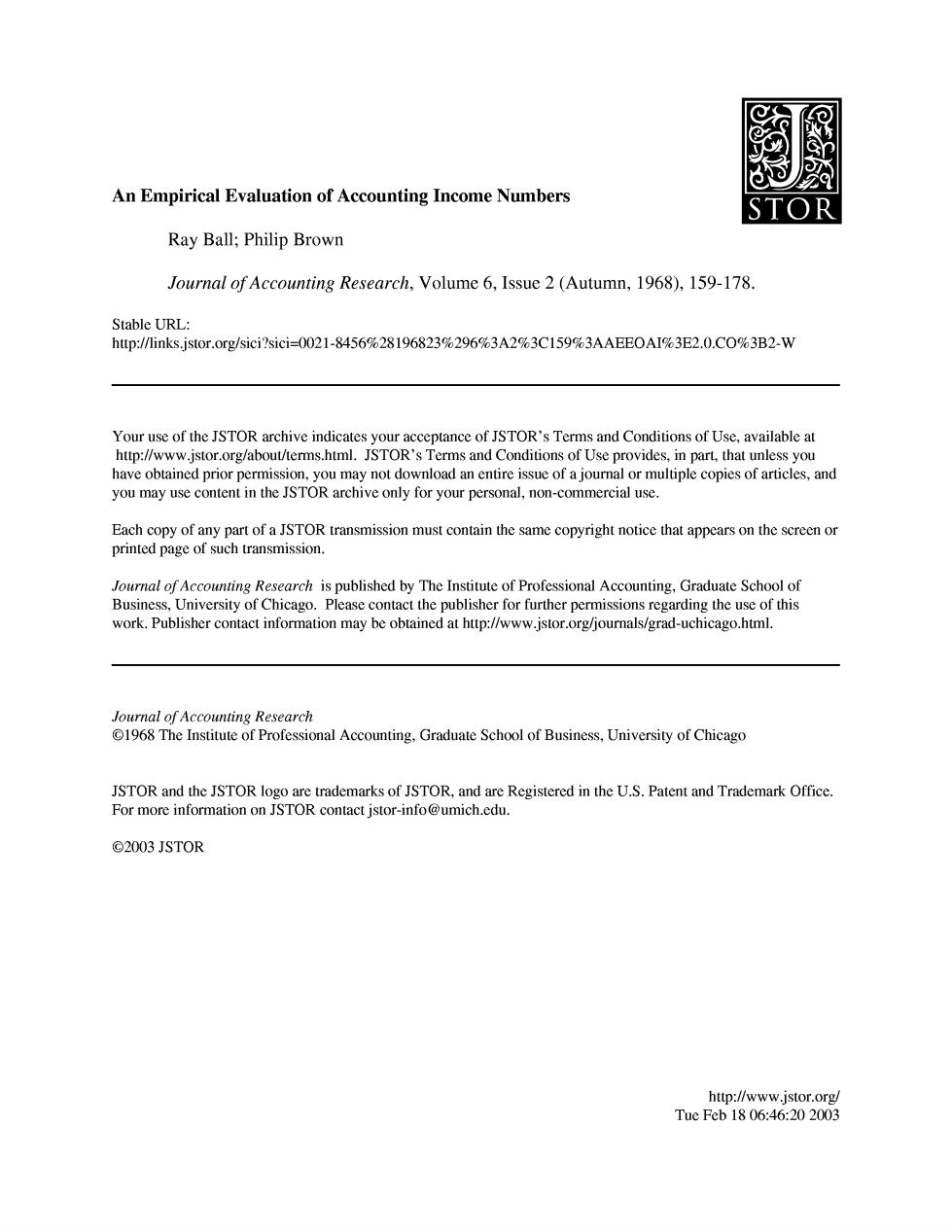
An Empirical Evaluation of Accounting Income Numbers STOR Ray Ball;Philip Brown Journal of Accounting Research,Volume 6,Issue 2 (Autumn,1968),159-178. Stable URL: http://links.istor.org/sici?sici=0021-8456%28196823%296%3A2%3C159%3AAEEOA13E2.0.CO%3B2-W Your use of the JSTOR archive indicates your acceptance of JSTOR's Terms and Conditions of Use,available at http://www.jstor.org/about/terms.html.JSTOR's Terms and Conditions of Use provides,in part,that unless you have obtained prior permission,you may not download an entire issue of a journal or multiple copies of articles,and you may use content in the JSTOR archive only for your personal,non-commercial use. Each copy of any part of a JSTOR transmission must contain the same copyright notice that appears on the screen or printed page of such transmission. Journal ofAccounting Research is published by The Institute of Professional Accounting,Graduate School of Business,University of Chicago.Please contact the publisher for further permissions regarding the use of this work.Publisher contact information may be obtained at http://www.jstor.org/journals/grad-uchicago.html. Journal of Accounting Research 1968 The Institute of Professional Accounting,Graduate School of Business,University of Chicago JSTOR and the JSTOR logo are trademarks of JSTOR,and are Registered in the U.S.Patent and Trademark Office. For more information on JSTOR contact jstor-info@umich.edu. ©2003 JSTOR http://www.jstor.org/ Tue Feb1806:46:202003
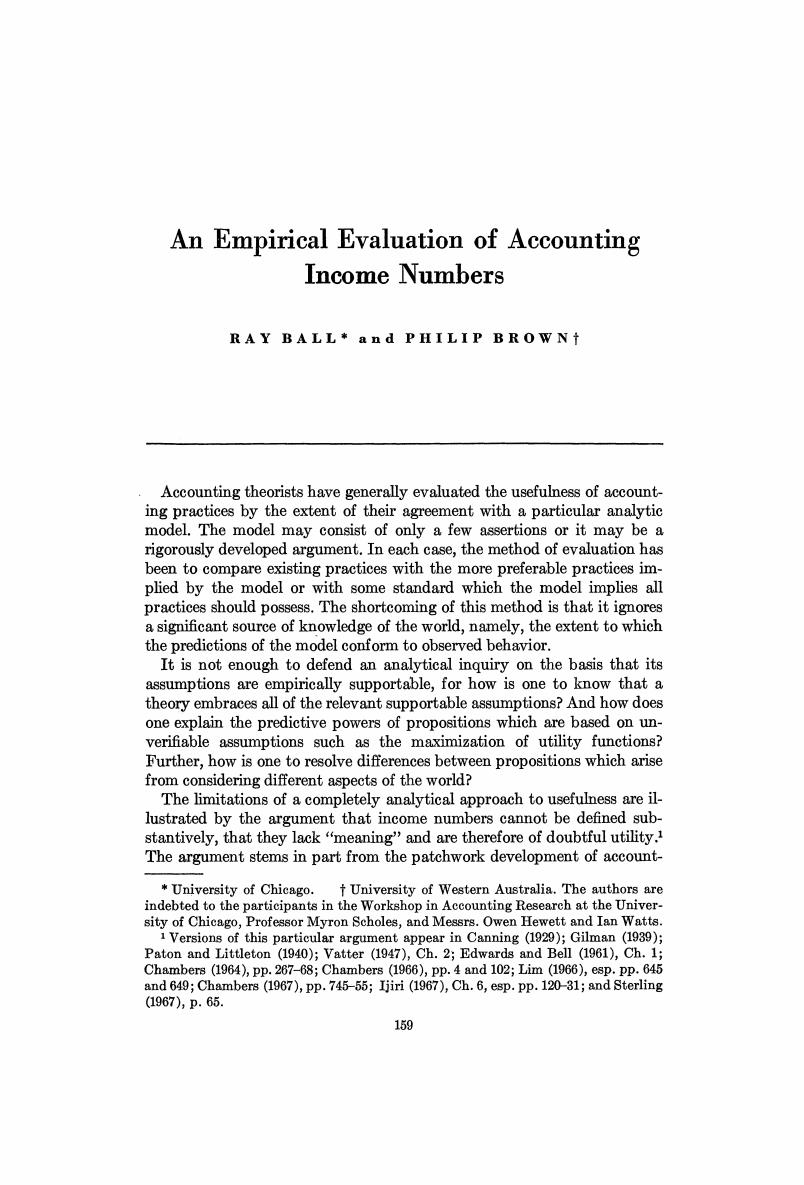
An Empirical Evaluation of Accounting Income Numbers RAY BALL*and PHILIP BROW N Accounting theorists have generally evaluated the usefulness of account- ing practices by the extent of their agreement with a particular analytic model.The model may consist of only a few assertions or it may be a rigorously developed argument.In each case,the method of evaluation has been to compare existing practices with the more preferable practices im- plied by the model or with some standard which the model implies all practices should possess.The shortcoming of this method is that it ignores a significant source of knowledge of the world,namely,the extent to which the predictions of the model conform to observed behavior. It is not enough to defend an analytical inquiry on the basis that its assumptions are empirically supportable,for how is one to know that a theory embraces all of the relevant supportable assumptions?And how does one explain the predictive powers of propositions which are based on un- verifiable assumptions such as the maximization of utility functions? Further,how is one to resolve differences between propositions which arise from considering different aspects of the world? The limitations of a completely analytical approach to usefulness are il- lustrated by the argument that income numbers cannot be defined sub- stantively,that they lack "meaning"and are therefore of doubtful utility.1 The argument stems in part from the patchwork development of account- *University of Chicago.University of Western Australia.The authors are indebted to the participants in the Workshop in Accounting Research at the Univer- sity of Chicago,Professor Myron Scholes,and Messrs.Owen Hewett and Ian Watts. 1 Versions of this particular argument appear in Canning (1929);Gilman(1939); Paton and Littleton (1940);Vatter (1947),Ch.2;Edwards and Bell (1961),Ch.1; Chambers (1964),pp.267-68;Chambers (1966),pp.4 and 102;Lim (1966),esp.pp.645 and 649;Chambers (1967),pp.745-55;Ijiri (1967),Ch.6,esp.pp.120-31;and Sterling (1967),p.65. 159
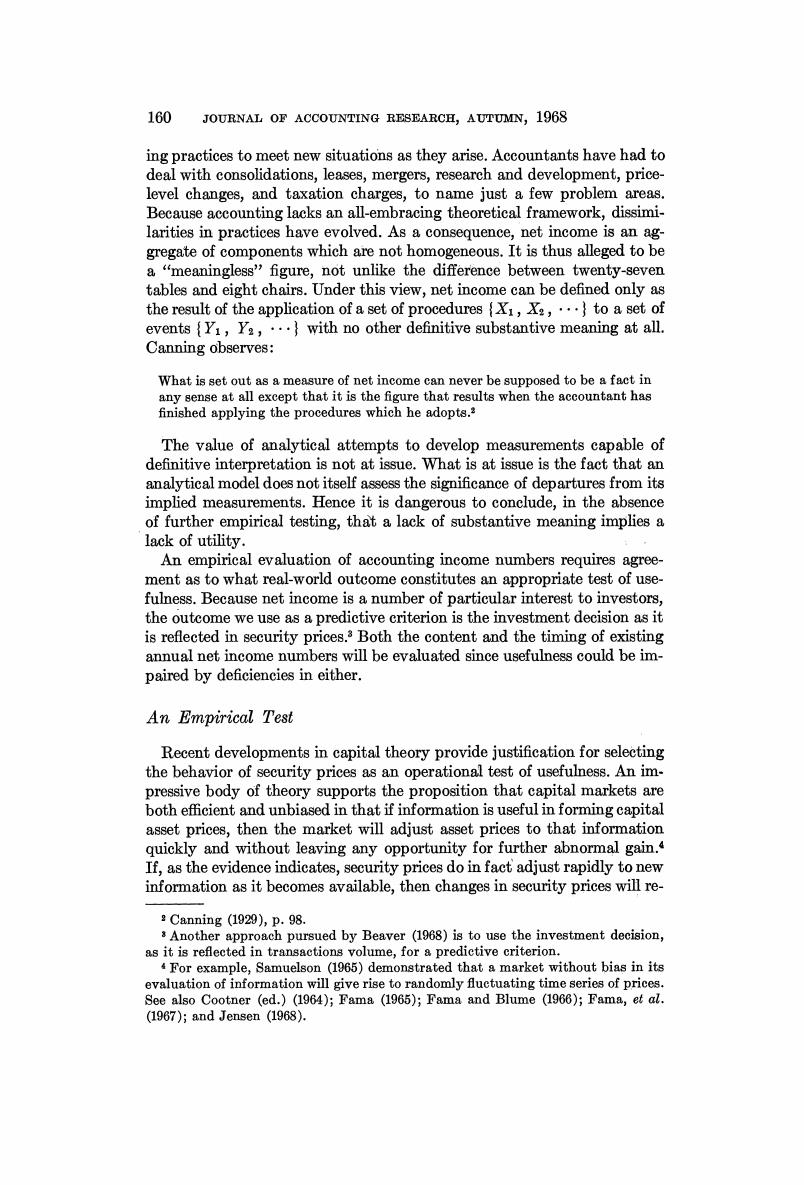
160 JOURNAL OF ACCOUNTING RESEARCH,AUTUMN,1968 ing practices to meet new situations as they arise.Accountants have had to deal with consolidations,leases,mergers,research and development,price- level changes,and taxation charges,to name just a few problem areas. Because accounting lacks an all-embracing theoretical framework,dissimi- larities in practices have evolved.As a consequence,net income is an ag- gregate of components which are not homogeneous.It is thus alleged to be a "meaningless"figure,not unlike the difference between twenty-seven tables and eight chairs.Under this view,net income can be defined only as the result of the application of a set of procedures Xi,X2,...}to a set of events Y1,Y2,...}with no other definitive substantive meaning at all. Canning observes: What is set out as a measure of net income can never be supposed to be a fact in any sense at all except that it is the figure that results when the accountant has finished applying the procedures which he adopts.3 The value of analytical attempts to develop measurements capable of definitive interpretation is not at issue.What is at issue is the fact that an analytical model does not itself assess the significance of departures from its implied measurements.Hence it is dangerous to conclude,in the absence of further empirical testing,that a lack of substantive meaning implies a lack of utility. An empirical evaluation of accounting income numbers requires agree- ment as to what real-world outcome constitutes an appropriate test of use- fulness.Because net income is a number of particular interest to investors, the outcome we use as a predictive criterion is the investment decision as it is reflected in security prices.3 Both the content and the timing of existing annual net income numbers will be evaluated since usefulness could be im- paired by deficiencies in either. An Empirical Test Recent developments in capital theory provide justification for selecting the behavior of security prices as an operational test of usefulness.An im- pressive body of theory supports the proposition that capital markets are both efficient and unbiased in that if information is useful in forming capital asset prices,then the market will adjust asset prices to that information quickly and without leaving any opportunity for further abnormal gain. If,as the evidence indicates,security prices do in fact adjust rapidly to new information as it becomes available,then changes in security prices will re- Canning (1920),p.98. 3 Another approach pursued by Beaver (1968)is to use the investment decision, as it is refected in transactions volume,for a predictive criterion. For example,Samuelson (1965)demonstrated that a market without bias in its evaluation of information will give rise to randomly fluctuating time series of prices. See also Cootner (ed.)(1964);Fama (1965);Fama and Blume (1966);Fama,et al. (1967);and Jensen(1968)
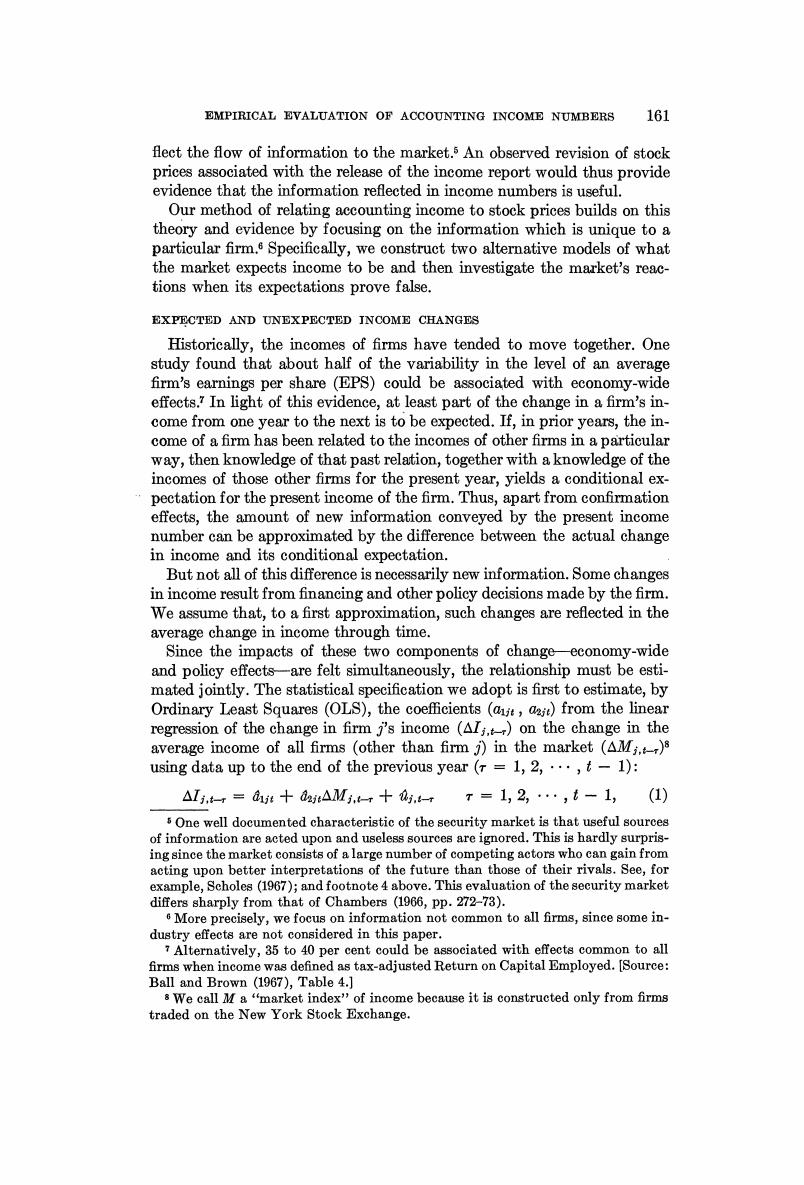
EMPIRICAL EVALUATION OF ACCOUNTING INCOME NUMBERS 161 flect the flow of information to the market.5 An observed revision of stock prices associated with the release of the income report would thus provide evidence that the information reflected in income numbers is useful. Our method of relating accounting income to stock prices builds on this theory and evidence by focusing on the information which is unique to a particular firm.6 Specifically,we construct two alternative models of what the market expects income to be and then investigate the market's reac- tions when its expectations prove false. EXPECTED AND UNEXPECTED INCOME CHANGES Historically,the incomes of firms have tended to move together.One study found that about half of the variability in the level of an average firm's earnings per share (EPS)could be associated with economy-wide effects.7 In light of this evidence,at least part of the change in a firm's in- come from one year to the next is to be expected.If,in prior years,the in- come of a firm has been related to the incomes of other firms in a particular way,then knowledge of that past relation,together with a knowledge of the incomes of those other firms for the present year,yields a conditional ex- pectation for the present income of the firm.Thus,apart from confirmation effects,the amount of new information conveyed by the present income number can be approximated by the difference between the actual change in income and its conditional expectation. But not all of this difference is necessarily new information.Some changes in income result from financing and other policy decisions made by the firm. We assume that,to a first approximation,such changes are reflected in the average change in income through time. Since the impacts of these two components of change-economy-wide and policy effects-are felt simultaneously,the relationship must be esti- mated jointly.The statistical specification we adopt is first to estimate,by Ordinary Least Squares (OLS),the coefficients (ai,z)from the linear regression of the change in firm i's income(AIj.+)on the change in the average income of all firms (other than firm j)in the market (AMj.)8 using data up to the end of the previous year (r 1,2,...,-1): △Ii,tr=dit+dAMi,tr十ai,tr T=1,2,…,t-1, (1) s One well documented characteristic of the security market is that useful sources of information are acted upon and useless sources are ignored.This is hardly surpris- ing since the market consists of a large number of competing actors who can gain from acting upon better interpretations of the future than those of their rivals.See,for example,Scholes(1967);and footnote 4 above.This evaluation of the security market differs sharply from that of Chambers (1966,pp.272-73). e More precisely,we focus on information not common to all firms,since some in- dustry effects are not considered in this paper. 7Alternatively,35 to 40 per cent could be associated with effects common to all firms when income was defined as tax-adjusted Return on Capital Employed.[Source: Ball and Brown (1967),Table 4.] 8 We call M a "market index"of income because it is constructed only from firms traded on the New York Stock Exchange
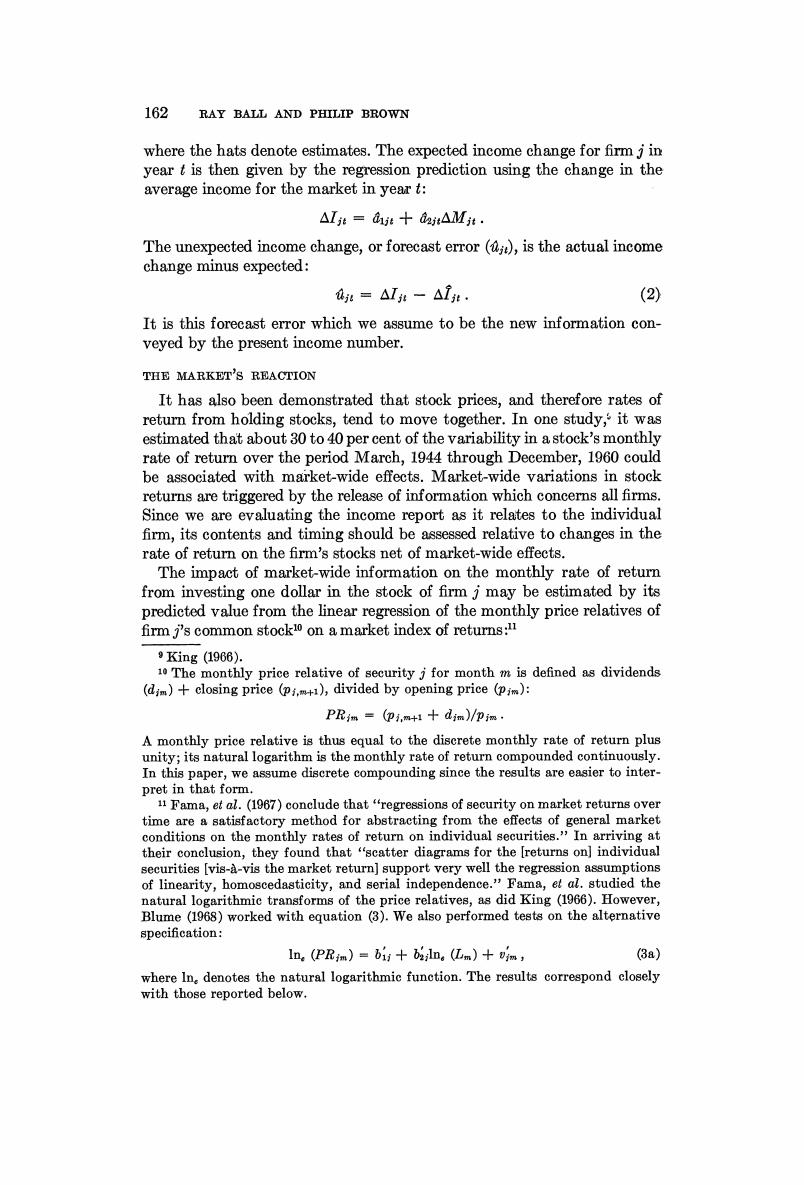
162 RAY BALL AND PHILIP BROWN where the hats denote estimates.The expected income change for firm j in year t is then given by the regression prediction using the change in the average income for the market in year t: △Iit=djt+d2t△Mit. The unexpected income change,or forecast error ()is the actual income change minus expected: a6=△Ir-△1. (2) It is this forecast error which we assume to be the new information con- veyed by the present income number. THE MARKET'S REACTION It has also been demonstrated that stock prices,and therefore rates of return from holding stocks,tend to move together.In one study,it was estimated that about 30 to 40 per cent of the variability in a stock's monthly rate of return over the period March,1944 through December,1960 could be associated with market-wide effects.Market-wide variations in stock returns are triggered by the release of information which concerns all firms. Since we are evaluating the income report as it relates to the individual firm,its contents and timing should be assessed relative to changes in the rate of return on the firm's stocks net of market-wide effects. The impact of market-wide information on the monthly rate of return from investing one dollar in the stock of firm j may be estimated by its predicted value from the linear regression of the monthly price relatives of firm i's common stock1o on a market index of returns:1 9King(1966). 10 The monthly price relative of security j for month m is defined as dividends (dim)+closing price (pi),divided by opening price (pjm): PRm=(pi,m+1十dm)/pm, A monthly price relative is thus equal to the discrete monthly rate of return plus unity;its natural logarithm is the monthly rate of return compounded continuously. In this paper,we assume discrete compounding since the results are easier to inter- pret in that form. 11 Fama,et al.(1967)conclude that "regressions of security on market returns over time are a satisfactory method for abstracting from the effects of general market conditions on the monthly rates of return on individual securities."In arriving at their conclusion,they found that "scatter diagrams for the [returns on]individual securities [vis-a-vis the market return]support very well the regression assumptions of linearity,homoscedasticity,and serial independence."Fama,et al.studied the natural logarithmic transforms of the price relatives,as did King(1966).However, Blume (1968)worked with equation(3).We also performed tests on the alternative specification: ln。(PRm)=bi十b2n。(亿m)+im, (3a) where In.denotes the natural logarithmic function.The results correspond closely with those reported below